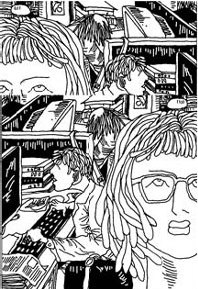Picture or story, details make the difference

On the strength of rave reviews in several photography magazines, I bought a lens that turned out to be a major disappointment. The pictures taken with the lens were as sharp as the advertisements said they would be. But the color seemed washed out, the contrast was lacking and the out-of-focus background was rough and uneven. Sharp as they were, these pictures just didn't "pop" on screen and in print.
Looking at these pictures, I was reminded of the many stories I read in newspapers and magazines, that were mostly informative but deadly boring.
Years ago when I was a reporter at a Hong Kong-based regional newspaper, my editor kept reminding us that to survive in the electronics age, we must learn to write stories that could not only enable the readers to quickly grasp the facts, but also to visualize the people and events behind the news. He loved to profess that we were the eye and ear of our readers who were too busy with their own gainful pursuits to be present at the scene of events that were of interest to them.

Of course, there is little use for sight and sound in writing about interest rates or bond prices. But when a reporter at a car show had only had stories of interviews with boastful auto executives to file, that reporter should be asked to do himself a favor by switching to a higher pay job, like public relations.
I am some sort of a car enthusiast. Although I haven't owned a car for years, I still buy and read various car magazines regularly. When I read about the launch of a new model, I'd like to know not only about the latest technology incorporated into the engine and the drive train, but, more importantly, what it feels like to be sitting in the driver's seat: the driving position, the layout of the instrument panel, the smell of the leather and, for me, at least, the placement of the pedals.
These are details that cannot be conveyed in pictures. They have to be meticulously presented in fluid prose. It is, as one of my former colleagues said, like expertly leading the readers in a dance.
Like most readers, I read many stories about the Sichuan earthquake. But I can only remember a few. The one that I can recall at any time recounted in vivid detail the ordeal of a couple squeezed against each other in a tight place under a pile of rubble for several days before they were rescued. In direct and elegant English, free of embarrassing hyperbole and chintzy sentimentality, the writer painted a picture that was sharply focused and emotionally stirring. It simply "popped" in the mind's eye.
Stories like that have reaffirmed our belief that journalism as a profession is not going to fade away with the demise of the print media. There will always be enough readers who value detail and reliable reporting and quality writing to keep the trade alive either in print or cyberspace.
Film is under threat of being pushed into extinction by the electronic sensor. But photography as an art form has continued to thrive.
So will news writing because every- body loves a good story well told.
E-mail: jamesleung@chinadaily.com.cn
(China Daily 01/13/2009 page8)














